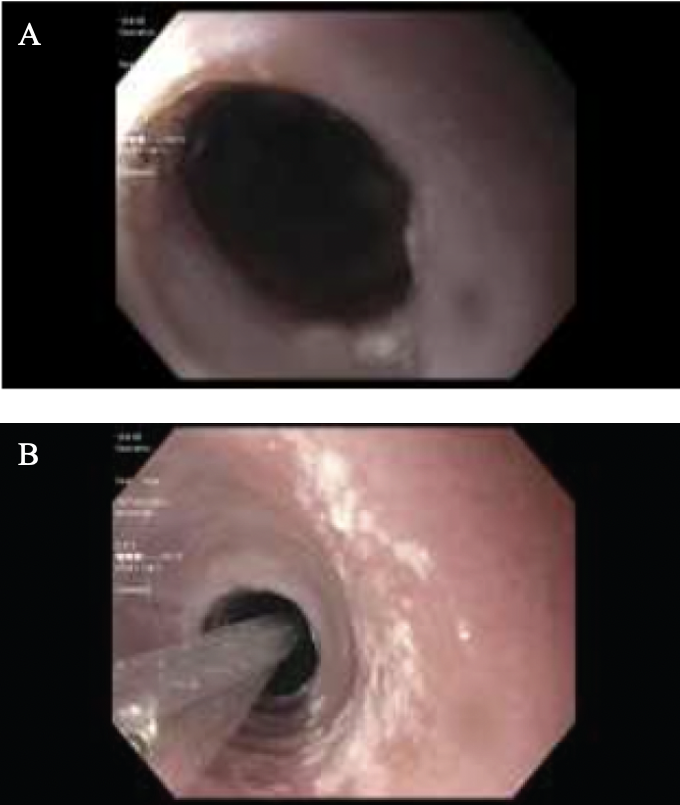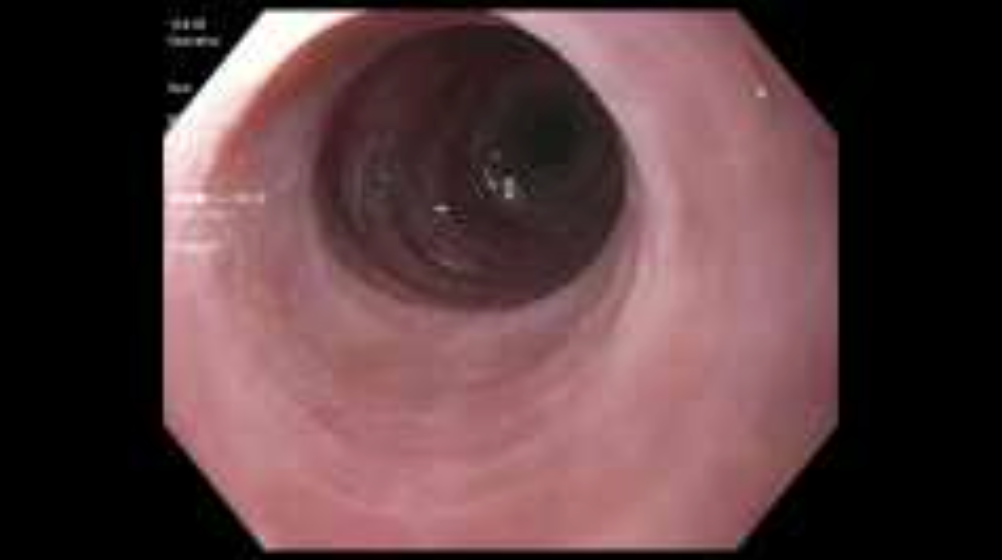Sunday Poster Session
Category: Esophagus
P0777 - Eosinophilic Esophagitis With Burnt out Esophagus: Dupilumab as a Rescue Therapy
Sunday, October 26, 2025
3:30 PM - 7:00 PM PDT
Location: Exhibit Hall

Arham Siddiqui, MD
University of Texas Health San Antonio
San Antonio, TX
Presenting Author(s)
Arham Siddiqui, MD1, Efan Jawad, MD2, Sabah Dossani, BS1, Charles Randall, MD1
1University of Texas Health San Antonio, San Antonio, TX; 2UT Health Science Center San Antonio, San Antonio, TX
Introduction: Eosinophilic esophagitis (EoE) is a well-known immune-mediated inflammatory disease characterized endoscopically using the Eosinophilic Esophagitis Endoscopic Reference Score (EREFS). In advanced cases, chronic inflammation can result in a “burnt-out” esophagus where fibrosis of the mucosa leads to negative biopsies. We present a unique case of a patient with burnt-out esophagus who responded significantly to dupilumab therapy.
Case Description/
Methods: A 34-year-old male with past medical history of Crohn’s disease presented to clinic for ongoing issues with dysphagia. Endoscopy revealed classic findings of EoE including a markedly narrow esophagus, deep linear furrows, and thickened prominent rings (EREFS score of 5). Multiple biopsies were obtained in both the proximal and distal esophagus which did not show active eosinophilic inflammation. He was clinically diagnosed with EoE with burnt-out esophagus and was started on proton pump inhibitor (PPI) therapy. Due to worsening symptoms, repeat endoscopy was pursued which showed a worsened EREFS score of 6 with narrowing of esophageal lumen to 6 mm preventing passage of the endoscope (see Figure 1). After dilation, the patient was started on dupilumab. After 12 weeks of therapy, he had significant improvement on repeat endoscopy (EREFS score of 4) with lumen diameter of 13 mm (see Figure 2). Repeat biopsies remained negative for eosinophilic inflammation.
Discussion: EoE is mediated by a Th2 cell-mediated response which releases factors such as IL-4, IL-5, and IL-13 which lead to esophageal immune cell infiltration. Although EoE with burnt-out esophagus has been previously described in the literature, there is limited data on effective treatment options. There are several standard modalities of treatment for EoE including acid suppression (PPIs), oral corticosteroids, and novel biologic therapies such as dupilumab. Dupilumab blocks the IL-4Rα receptor which inhibits signaling of both IL-4 and IL-13. Histologic analysis is traditionally considered the gold standard for both diagnosis and treatment response for EoE. However, in fibrotic or “burnt-out” disease, active eosinophilic inflammation may no longer be present despite ongoing endoscopic abnormalities. Our case highlights the benefit of dupilumab in patients with a high EREFS score in biopsy negative EoE. A randomized control trial should be designed to investigate the true efficacy of dupilumab for the endoscopic treatment of burnt-out esophagus.

Figure: Figure 1: (A) Narrowing of the upper third of the esophagus to 6 mm preventing passage of the endoscope; (B) Deployment of balloon dilator in upper third of the esophagus

Figure: Figure 2: Middle third of the esophagus measured at 13 mm after dupilumab therapy
Disclosures:
Arham Siddiqui indicated no relevant financial relationships.
Efan Jawad indicated no relevant financial relationships.
Sabah Dossani indicated no relevant financial relationships.
Charles Randall indicated no relevant financial relationships.
Arham Siddiqui, MD1, Efan Jawad, MD2, Sabah Dossani, BS1, Charles Randall, MD1. P0777 - Eosinophilic Esophagitis With Burnt out Esophagus: Dupilumab as a Rescue Therapy, ACG 2025 Annual Scientific Meeting Abstracts. Phoenix, AZ: American College of Gastroenterology.
1University of Texas Health San Antonio, San Antonio, TX; 2UT Health Science Center San Antonio, San Antonio, TX
Introduction: Eosinophilic esophagitis (EoE) is a well-known immune-mediated inflammatory disease characterized endoscopically using the Eosinophilic Esophagitis Endoscopic Reference Score (EREFS). In advanced cases, chronic inflammation can result in a “burnt-out” esophagus where fibrosis of the mucosa leads to negative biopsies. We present a unique case of a patient with burnt-out esophagus who responded significantly to dupilumab therapy.
Case Description/
Methods: A 34-year-old male with past medical history of Crohn’s disease presented to clinic for ongoing issues with dysphagia. Endoscopy revealed classic findings of EoE including a markedly narrow esophagus, deep linear furrows, and thickened prominent rings (EREFS score of 5). Multiple biopsies were obtained in both the proximal and distal esophagus which did not show active eosinophilic inflammation. He was clinically diagnosed with EoE with burnt-out esophagus and was started on proton pump inhibitor (PPI) therapy. Due to worsening symptoms, repeat endoscopy was pursued which showed a worsened EREFS score of 6 with narrowing of esophageal lumen to 6 mm preventing passage of the endoscope (see Figure 1). After dilation, the patient was started on dupilumab. After 12 weeks of therapy, he had significant improvement on repeat endoscopy (EREFS score of 4) with lumen diameter of 13 mm (see Figure 2). Repeat biopsies remained negative for eosinophilic inflammation.
Discussion: EoE is mediated by a Th2 cell-mediated response which releases factors such as IL-4, IL-5, and IL-13 which lead to esophageal immune cell infiltration. Although EoE with burnt-out esophagus has been previously described in the literature, there is limited data on effective treatment options. There are several standard modalities of treatment for EoE including acid suppression (PPIs), oral corticosteroids, and novel biologic therapies such as dupilumab. Dupilumab blocks the IL-4Rα receptor which inhibits signaling of both IL-4 and IL-13. Histologic analysis is traditionally considered the gold standard for both diagnosis and treatment response for EoE. However, in fibrotic or “burnt-out” disease, active eosinophilic inflammation may no longer be present despite ongoing endoscopic abnormalities. Our case highlights the benefit of dupilumab in patients with a high EREFS score in biopsy negative EoE. A randomized control trial should be designed to investigate the true efficacy of dupilumab for the endoscopic treatment of burnt-out esophagus.

Figure: Figure 1: (A) Narrowing of the upper third of the esophagus to 6 mm preventing passage of the endoscope; (B) Deployment of balloon dilator in upper third of the esophagus

Figure: Figure 2: Middle third of the esophagus measured at 13 mm after dupilumab therapy
Disclosures:
Arham Siddiqui indicated no relevant financial relationships.
Efan Jawad indicated no relevant financial relationships.
Sabah Dossani indicated no relevant financial relationships.
Charles Randall indicated no relevant financial relationships.
Arham Siddiqui, MD1, Efan Jawad, MD2, Sabah Dossani, BS1, Charles Randall, MD1. P0777 - Eosinophilic Esophagitis With Burnt out Esophagus: Dupilumab as a Rescue Therapy, ACG 2025 Annual Scientific Meeting Abstracts. Phoenix, AZ: American College of Gastroenterology.
